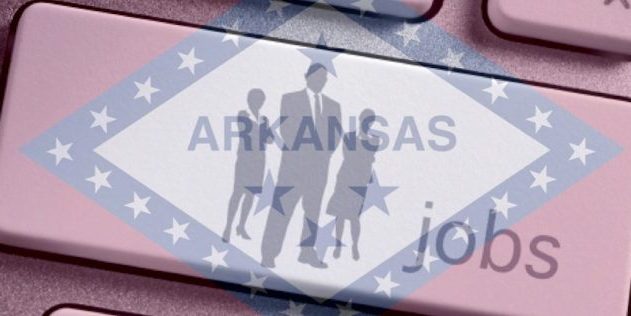April report shows more than 68,000 jobs return to state economy; jobless rate holds at 4.4%
by May 21, 2021 11:37 am 757 views

The April jobs report is a clear sign the state’s economy is in recovery, with job gains up 5.5% compared with April 2020, and the number of unemployed down 56.7%. The tourism sector posted the biggest recovery with a 47.3% year-over-year jobs gain.
Arkansas’ jobless rate in April was 4.4%, unchanged from March and well below the 10% in April 2020 – the highest monthly jobless rate during the COVID-19 pandemic. The number of employed in Arkansas during April was an estimated 1,302,691, up 68,488 jobs compared with April 2020, according to Friday’s (May 21) report from the U.S. Bureau of Labor Statistics (BLS).
“Our stable unemployment rate assures me that we are steadily moving in the right direction after more than a year of COVID-19,” Gov. Asa Hutchinson said in a statement. “Before the pandemic, our economy was strong. We’ve encountered many challenges over the past 15 months, but we have persevered and fought our way back from the 10 percent rate a year ago.”
The April numbers are preliminary and subject to revision. The report marked 13 months of COVID-19 impacts on the economy.
The state’s labor force – the number of people eligible to work – was 1,362,081 in April, down compared with the 1,371,571 in April 2020, and above the 1,360,097 in March. Arkansans without jobs in April totaled 59,389, down from 60,184 in March but much better than the 137,367 in April 2020 when many parts of the state economy were essentially closed.
The biggest sector gains were in Leisure & Hospitality (35,500 more jobs), Trade, Transportation & Utilities (up 16,300 jobs) and Professional & Business Services (up 14,600 jobs). The only large sector to lose jobs was Government, with 800 fewer jobs compared with April 2020. Even with the significant jobs gain in the tourism sector (Leisure & Hospitality), employment is down more than 12,000 jobs from record employment in the sector.
GROWTH WITH THE ‘UI BOOST’
Mervin Jebaraj, director of the Center for Business and Economic Research at the University of Arkansas, said the tourism sector job gains are not unexpected.
“It’s not terribly surprising to see the improvements in employment in food services in Arkansas in April. The sector showed strong employment in the national data released earlier this month and indicates that businesses in that sector are slowly recovering. It’s important to note that the labor force was growing again in April, even with the $300 UI boost and before any announcements were made about it ending,” Jebaraj noted in a statement to Talk Business & Politics.
Several state governors, including Gov. Hutchinson, have ended participation in federal supplemental jobless benefits which provided an extra $300 a week to those who qualified. The governors said the expanded jobless benefit discouraged people from re-entering the workforce. Arkansas’ extra unemployment insurance benefit ended 10 weeks early.
The $1.9 trillion American Rescue Plan signed into law in early March by President Joe Biden included $300-a-week federal unemployment benefits through September. The plan also included $1,400 per-person stimulus checks and $350 billion to state, local and tribal governments to cover deficits resulting from the pandemic. The $300 a week equals a $15,600 annual salary.
A May 2021 study published by the Federal Reserve Bank of San Francisco indicated only one in seven receiving the extra $300 “decides to decline the (job) offer due to the availability of the extra $300 a week in UI payments.”
Unemployment rates were lower in April in 12 states and stable in 38 states, according to the BLS report. Forty-eight states and the District had jobless rate decreases from a year earlier and two states had little change. Hawaii had the highest unemployment rate in April at 8.5%, followed by California at 8.3%, and New Mexico and New York at 8.2% each. Nebraska, New Hampshire, South Dakota, and Utah had the lowest rates at 2.8% each. In total, 27 states had unemployment rates lower than the U.S. figure of 6.1%, 11 states had higher rates, and 12 states had rates that were not appreciably different from that of the nation.
JOB SECTOR NUMBERS
Jobs in the Trade, Transportation, and Utilities sector – the state’s largest job category – was 250,100 in April, down from 251,400 in March and above from 233,800 in April 2020. The sector reached a record employment of 253,700 in January 2020.
The Government sector employed 205,500 in April, up from 205,200 in March and below 206,300 in April 2020. Sector employment hit a peak of 224,100 in May 2010.
The Education and Health Services sector employed 188,500 in April, up from 188,000 in March and above the 176,800 in April 2020. February 2020 set a record for sector employment at 195,300.
Arkansas’ manufacturing sector had 159,800 jobs, down from 161,200 in March and up from 149,800 jobs in April 2020. Manufacturing, once the state’s largest jobs sector, posted a record employment of 247,600 in July 1995.
Professional and Business Services employed 143,900 in April, up from 143,800 in March, and well above the 129,300 April 2020. The sector reached a record employment of 147,100 in January 2020.
The state’s Leisure and Hospitality (tourism) sector had 110,600 jobs in April, up from 109,800 in March and above 75,100 in April 2020. The sector first reached an employment record of 122,900 in December 2019.
The Financial Activities sector had 64,400 jobs in April, down from 65,000 in March and up from 63,000 in April 2020. The sector first hit record employment of 64,300 in February 2020.
The Construction sector had 54,600 jobs in April, up from 54,500 in March and up from 51,800 in April 2020. The sector reached a record employment of 54,700 in November 2020.
